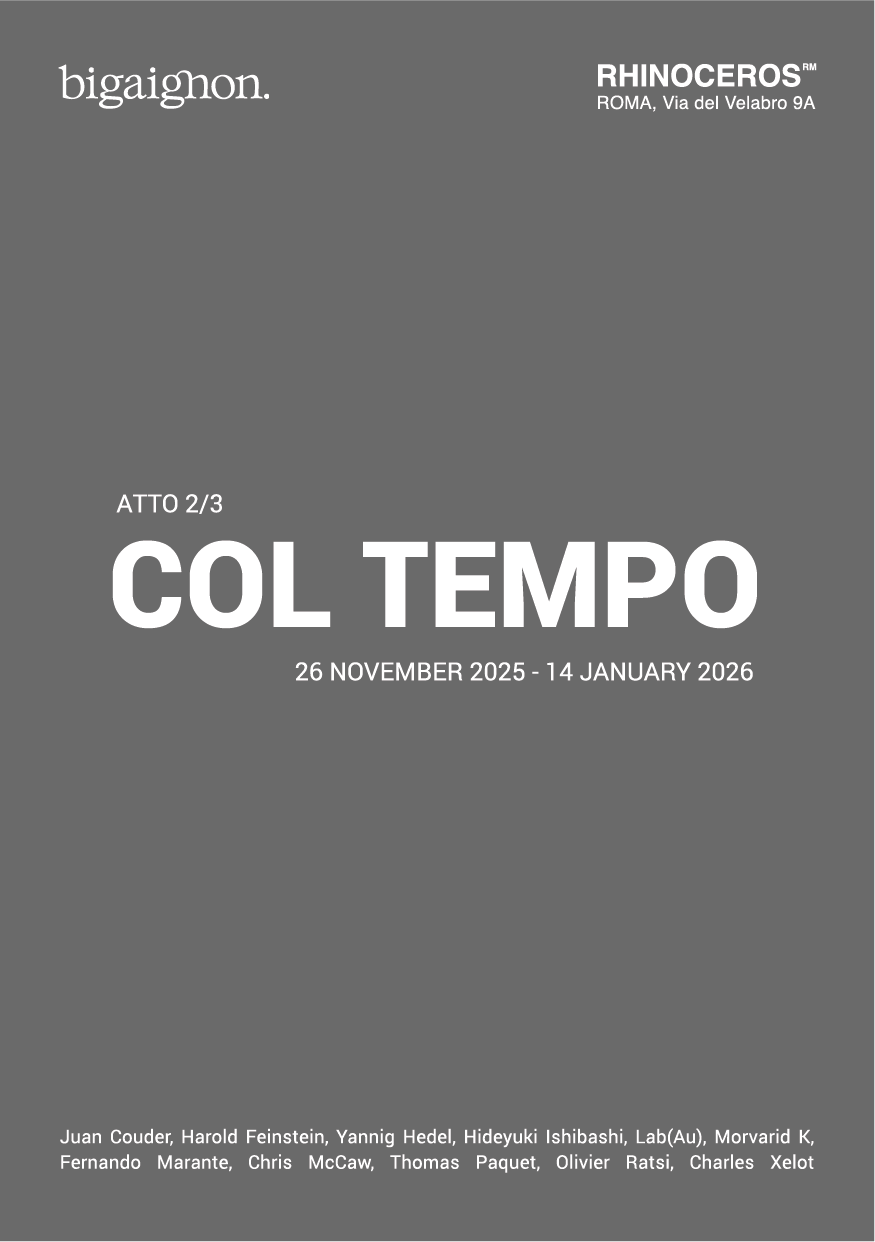Group SHOW • ATTO 2/3: COL TEMPO
BIGAIGNON x RHINOCEROS GALLERY, ROME, ITALY
OPENING: THURSDAY 26 NOVEMBER 2025 (6-8PM)
EXHIBITION FROM 26 NOVEMBER 2025 TO 14 JANUARY 2026
Artists: Juan Couder, Harold Feinstein, Yannig Hedel, Hideyuki Ishibashi, Lab(Au), Morvarid K, Fernando Marante, Chris McCaw, Thomas Paquet, Olivier Ratsi, Charles Xelot
We are pleased to announce our second exhibition in Rome, the result of our partnership with Rhinoceros — a unique venue conceived by Alda Fendi and designed by Jean Nouvel, located in the very heart of the Italian capital. Entitled “Atto 2/3: Col Tempo,” this exhibition, devoted to an element as fundamental as time, marks the second act of a three-part cycle that unfolds until March 2026.
Time — invisible and elusive — forms the fabric of all human experience and stands as one of art’s essential materials. If photography is defined by light and space, it is equally defined by time: photography cuts it, suspends it, transforms it into a tangible substance. Every image is a fragment of duration frozen in its momentum — a moment that refuses to disappear.
Artists have long sought to understand what time does to form, to the body, to memory. Heraclitus saw the world as a perpetual flow, while Saint Augustine, meditating in Rome itself, marveled at this paradox: time exists only within human consciousness, stretched between the memory of the past and the anticipation of the future. In Rome, this reflection takes on a special resonance. Here, time becomes visible, almost tangible. Layers of history overlap like strata of memory: ruins converse with the present, ancient stones meet the light of a new day. The Eternal City reminds us that time is not only what passes, but also what endures.
The artists gathered for this exhibition explore this invisible, fluid, and persistent material. Through trace, layering, repetition, or, conversely, the brilliance of a single fleeting instant, they probe the tension between transience and permanence. Thomas Paquet captures the trace of time over an entire year using cyanotype — as does Spanish artist Juan Couder, though in a different way. Morvarid K, through performance, kneads her photographic paper with temporal traces. Hideyuki Ishibashi, in his Latent series, evokes time through memory. In a more conceptual yet equally powerful approach, the Belgian collective Lab(au) presents a monochrome that seems to take the form of a two-tone painting. Using uranium powder on one side and lead on the other, it is time itself that will turn this work into a monochrome — for the only thing separating these two materials is time (millions of years, in this case!). French artist Yannig Hedel and American artist Chris McCaw both offer masterful compositions that poetically evoke the inscription of passing time. As philosopher Henri Bergson reminds us, lived time — duration — cannot be measured but rather felt; it contracts or thickens according to our emotions and memories. Guest artist Charles Xelot makes this duration visible. Finally, Portuguese artist Fernando Marante and American photographer Harold Feinstein invite us to contemplate time as a living substance: in one’s work, it stretches like a tranquil wave; in the other’s, it unfolds image after image, like a cinematic sequence.
In an era saturated with instant images and fleeting information, to rethink time — its slowness, its depth, its density — becomes an almost political act. Perhaps, in the end, art’s true purpose is to give form to time, so that, for just a moment longer, we may inhabit it differently.
In parallel, since last September and continuing through March 2026, Bigaignon has occupied a space on the first floor of this historic building with a major installation by Olivier Ratsi. A true synthesis of the three exhibitions planned at Rhinoceros, this immersive work brings together the three themes that the French gallery seeks to explore during its residency in Rome: light, time, and space.

